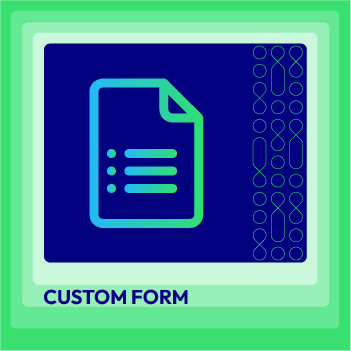4 Steps to Create a Custom Form in Magento 2 Admin
Vinh Jacker | 03-17-2025
Normally, the default configuration of Magento 2 is not able to meet all the demands of online merchants. To collect customer information which is important to create a personalized shopping experience, the store admin needs more than what Magento Default provides. Using forms is a great way to do that.
It is essential for every e-commerce store to create a custom form in Magento 2. Interestingly, Magento 2 comes with UI components, which assist store owners in creating a custom form with many useful features.
In this article, I will show you how to do that through 4 steps To Create A Custom Form In Magento 2!
- Step 1: Create A Controller File
- Step 2: Create A Layout File
- Step 3: Create A UI Component File
- Step 4: Create A Provider File
Step 1: Create A Controller File
Firstly, you need to create a controller file
app/code/[Name_Space]/[Your_Module]/Controller/Adminhtml/SampleForm/Index.php
<?php
namespace [Name_Space]\[Your_Module]\Controller\Adminhtml\SampleForm;
class Index extends \Magento\Framework\App\Action\Action
{
/** @var \Magento\Framework\View\Result\PageFactory */
protected $resultPageFactory;
public function __construct(
\Magento\Framework\App\Action\Context $context,
\Magento\Framework\View\Result\PageFactory $resultPageFactory
) {
$this->resultPageFactory = $resultPageFactory;
parent::__construct($context);
}
/**
* Load the page defined in view/adminhtml/layout/samplenewpage_sampleform_index.xml
*
* @return \Magento\Framework\View\Result\Page
*/
public function execute()
{
return $this->resultPageFactory->create();
}
}
Step 2: Create A Layout File
In the next step, you are required to create a layout file
app/code/[Name_Space]/[Your_Module]/view/adminhtml/
layout/samplenewpage_sampleform_index.xml
<?xml version="1.0"?>
<!--
/**
* Copyright © 2016 Magento. All rights reserved.
* See COPYING.txt for license details.
*/
-->
<page xmlns:xsi="http://www.w3.org/2001/XMLSchema-instance" layout="admin-2columns-left" xsi:noNamespaceSchemaLocation="../../../../../../../lib/internal/Magento/Framework/View/Layout/etc/page_configuration.xsd">
<head>
<title>
Sample Form
</title>
</head>
<body>
<referenceContainer name="content">
<uiComponent name="sampleform_form"/>
</referenceContainer>
</body>
</page>
Step 3: Create The UI Component File
In the third step, please create the UI component file
app/code/[Name_Space]/[Your_Module]/view/adminhtml/ui_component/sampleform_form.xml
<?xml version="1.0" encoding="UTF-8"?>
<!--
/**
* Copyright © 2016 Magento. All rights reserved.
* See COPYING.txt for license details.
*/
-->
<form xmlns:xsi="http://www.w3.org/2001/XMLSchema-instance" xsi:noNamespaceSchemaLocation="../../../../../../../lib/internal/Magento/Framework/Ui/etc/ui_configuration.xsd">
<argument name="data" xsi:type="array">
<item name="js_config" xsi:type="array">
<item name="provider" xsi:type="string">sampleform_form.sampleform_form_data_source</item>
<item name="deps" xsi:type="string">sampleform_form.sampleform_form_data_source</item>
</item>
<item name="label" xsi:type="string" translate="true">Sample Form</item>
<item name="layout" xsi:type="array">
<item name="type" xsi:type="string">tabs</item>
</item>
</argument>
<dataSource name="sampleform_form_data_source">
<argument name="dataProvider" xsi:type="configurableObject">
<argument name="class" xsi:type="string">[Name_Space]\[Your_Module]\Model\DataProvider</argument>
<argument name="name" xsi:type="string">sampleform_form_data_source</argument>
<argument name="primaryFieldName" xsi:type="string">entity_id</argument>
<argument name="requestFieldName" xsi:type="string">id</argument>
</argument>
<argument name="data" xsi:type="array">
<item name="js_config" xsi:type="array">
<item name="component" xsi:type="string">Magento_Ui/js/form/provider</item>
</item>
</argument>
</dataSource>
<fieldset name="sample_fieldset">
<argument name="data" xsi:type="array">
<item name="config" xsi:type="array">
<item name="label" xsi:type="string" translate="true">Sample Fieldset</item>
</item>
</argument>
<!-- This field represents form id and is hidden -->
<field name="entity_id">
<argument name="data" xsi:type="array">
<item name="config" xsi:type="array">
<item name="visible" xsi:type="boolean">false</item>
<item name="dataType" xsi:type="string">text</item>
<item name="formElement" xsi:type="string">input</item>
<item name="source" xsi:type="string">sampleform</item>
</item>
</argument>
</field>
<!-- This field has data type 'text' and standard 'input' form element and looks like input -->
<field name="title">
<argument name="data" xsi:type="array">
<item name="config" xsi:type="array">
<item name="label" xsi:type="string">New title</item>
<item name="visible" xsi:type="boolean">true</item>
<item name="dataType" xsi:type="string">text</item>
<item name="formElement" xsi:type="string">input</item>
<item name="source" xsi:type="string">sampleform</item>
</item>
</argument>
</field>
</fieldset>
</form>
Step 4: Create Provider File
Lastly, you have to create the provider file to finish the process of creating the custom form with the UI component in Magento 2.
app/code/[Name_Space]\[Your_Module]\Model\DataProvider.php
<?php
/**
* Copyright © 2016 Magento. All rights reserved.
* See COPYING.txt for license details.
*/
namespace [Name_Space]\[Your_Module]\Model;
/**
* Class DataProvider
*/
class DataProvider extends \Magento\Ui\DataProvider\AbstractDataProvider
{
/**
* Get data
*
* @return array
*/
public function getData()
{
return [];
}
}

Custom Form extension for Magento 2
Set up conditional logic to show or hide form fields based on the customer's input, making the form more intuitive and user-friendly.
Learn moreConclusion
This is the detailed instruction for creating a custom form in Magento 2 with a UI component, which is one of the most popular forms in Magento 2 you have to be familiar with.
However, if you find the process too complex, we recommend utilizing a third-party module with a user-friendly interface and a more comprehensive range of features. For a simpler alternative, consider exploring the Magento 2 Custom Form extension, which provides ease of use and added versatility to meet your needs. Here’s a guide to learning how to create Custom Contact Form in Magento 2 frontend with the module.
I hope that this guide is useful for you! If you have any questions or want to discuss this post, feel free to leave a comment below!





![Top 20+ Must-have Shopify Apps for 2025 [Free & Paid] - Mageplaza](https://cdn2.mageplaza.com/media/blog/must-have-shopify-apps/top-must-have-shopify-apps.png)
![[2025 Updates] Top 10+ Upsell Apps for Shopify - Mageplaza](https://cdn2.mageplaza.com/media/blog/best-upsell-shopify-app/cover.png)